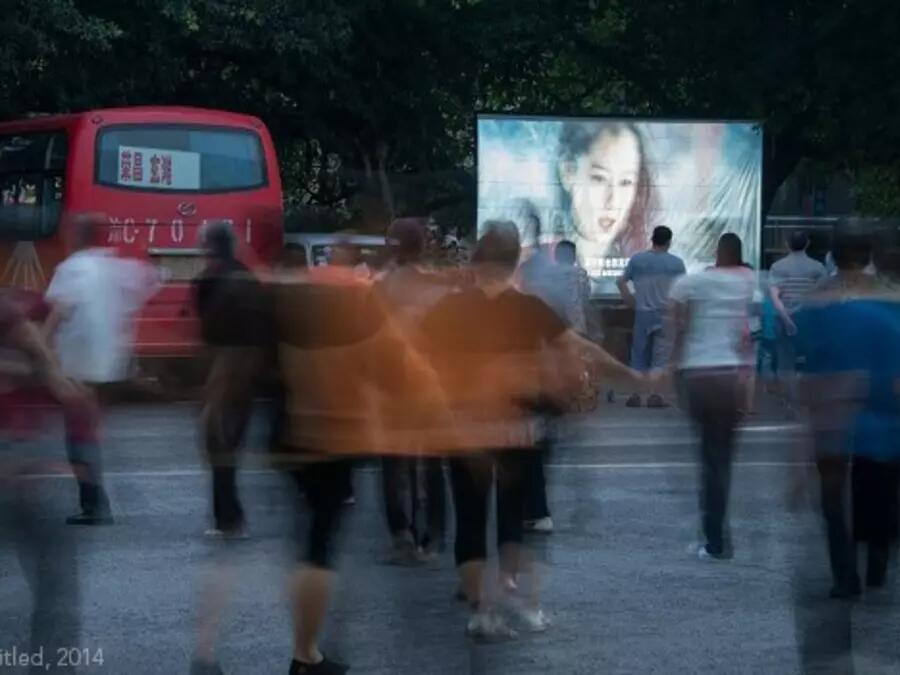
Tong Lam: Moving Images, Moving People
Tong Lam, Moving Images, Moving People
Scotiabank Contact Photography Festival Featured Exhibition
Curated by Tina Chen
A featured exhibition in this year’s Scotiabank Contact Photography Festival, Professor Tong Lam’s new body of photo and video work, Moving Images, Moving People, opens May 10, 2019, in the Bachir Yerex Presentation Space at 401 Richmond St in Toronto. For Lam, a historian and visual artist at the University of Toronto Mississauga and Asian Institute affiliated faculty member, the project is a generative opportunity “to think seriously about the interaction between art and scholarship, politics and aesthetics, as well as public dissemination.” The exhibition grew out of a collaborative research project initiated by Tina Chen, a historian examining economies of film production and circulation, particularly the phenomenon of outdoor, mobile cinema in China. A practice that originally flourished in 1950s-70s socialist China, the highly-coordinated state-led project saw projectionists mount myriad outdoor film screenings across the countryside. Illuminating the dark nighttime with the dazzling spectacle of moving images, the screenings promoted socialist citizenship, literacy and rural modernization to captivated crowds. The practice died out in the 1980s due to the popularization of TV, and, so, observing the re-emergence of outdoor, mobile cinema in China today, Chen asked Lam to collaborate through the production of documentary visual images. For Lam, the project spoke to his ongoing scholarly and artistic research on urban space, spectacle, and the formation of the political subject in post-socialist China.
Setting out to follow films brought to contemporary rural populations, Lam undertook a first research trip to Sichuan province in 2013. “As soon as I got there I realized the practice is not only happening in the countryside, and the project expanded and evolved very quickly,” he reflects. Discovering the proliferation of mobile, outdoor cinema across the city as much as the countryside, as well as in transitional, not-yet-urban spaces, such as construction site camps, the project shifted to more broadly question what it means to show outdoor films in post-socialist China. Although a reactivated state-led project, the phenomenon of outdoor, mobile cinema is no longer exclusively operated by the government. Big corporations engage in the practice, as do some NGOs that arrived in the post-earthquake devastated province. As a result, outdoor cinema reflects complex and heterogeneous interests, intersecting with a varied swathe of the country. “The selection of images had to capture this diversity of space and people,” Lam notes of his exhibition. Moving Images, Moving People renders this multiplicity, showing outdoor film screenings occurring in middleclass urban neighbourhoods, socio-economically marginalized neighbourhoods, in the middle of a mountain, or in construction worker camps housing migrant workers*, to name a few.
Lam’s work reflects on a context in which propaganda displayed on “beautiful LED screens everywhere in the city” slides seamlessly into corporate advertisements. “I’m trying to project that we cannot say this is simply communism or capitalism anymore. It is an integrated spectacle. Visually there is not much difference—the same kind of advertising firm produces state-sponsored messages and commercials.” For Lam, the exhibition seeks to “blur the binaries often produced by the cold-war narrative of east/west, democracy and communism, precisely to problematize those boundaries.” His images exceed the strictly documentary mode, embodying the highly varied practice of mobile, outdoor cinema in the networked, media-saturated China of today. Comprised of photo prints, images mounted on illuminated lightboxes, videos, as well as archival film footage, the show activates this dizzying, slippery global media landscape and the diffusion of attention across its many screens. Lam asks, “What does it mean to show outdoor films when everyone has a cell phone? It’s an almost antiquated practice.” He continues, “Within this multi-media context I question whether the films, especially propaganda films, still move people and in what sense they move people.” Lam notes that the screenings “no longer have the same impact or aura they used to,” and his images show audiences floating variously in and out of absorption, watching their own devices, even engaging in dance parties that ignore the screenings. “I don’t want to convey that this is a regime controlling everything by showing films all over the country. In reality it’s actually quite the opposite. In fact, it’s not effective. It’s just one other thing.” In Lam’s work, the historical focal point of the projection screen and its “moving” images disperses, breaks down, and multiplies. His images show a more expansive view, telling complex stories of movement as migration and rapid urbanization.
Upcoming talk at the Asian Institute: https://munkschool.utoronto.ca/ai/event/27286/
Scotiabank Contact Photography Festival:https://scotiabankcontactphoto.com/exhibition/moving-images-moving-people-2/
Presented by:
Reel Asian International Film Festival in partnership with Vtape
Supported by:
University of Manitoba
Asian Institute, Munk School of Global Affairs & Public Policy
Social Sciences and Humanities Research Council of Canada
*Lam delves into the particular context of screenings in China’s construction worker camps in an article “Portable and Precarious: Life and Spectacle in China’s Construction Camps” in the October, 2018 issue of Radical History Review, writing, “A key function of these screenings is to consume the workers’ remaining energy. The techno-aesthetics of outdoor cinema, in this regard, are enlisted to optimize the balance between exhaustion and recuperation in the management of the migrant body” (175).

